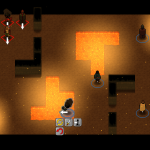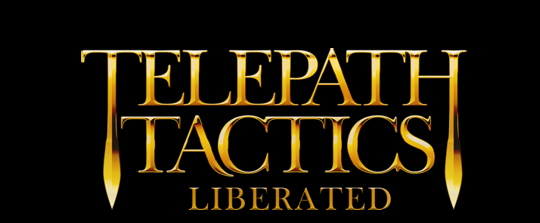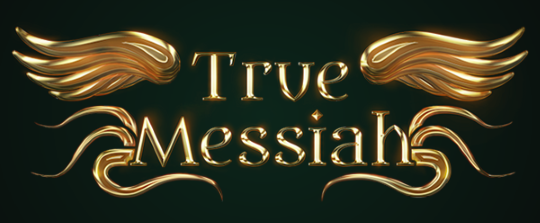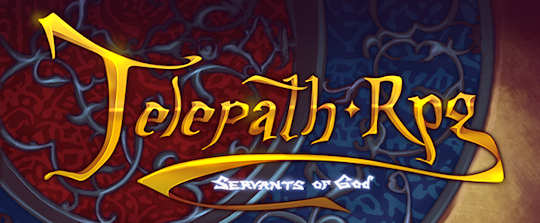“We already have The Battle for Wesnoth; what makes Telepath Tactics different?” I’ve gotten this question a few times now. The short answer is, “So many things that I would have to write an article to list them all.” And the long answer is…well, this article.
Why the comparison with The Battle for Wesnoth in the first place?
There is an argument to be made that this isn’t even a legitimate question to ask. Even if the games were similar, what would be the harm in having more than one game in a similar style on the same platform? Ask this sort of question of virtually any pair of similar games, and it sounds transparently silly. “We already have a ton of Fire Emblem games. Why do we need Fire Emblem: Awakening?” “We already have the Diablo series. Why do we need Torchlight?” The answer is obvious: variety. For someone who enjoys the core experience of these games, even the relatively small differences between Diablo and Torchlight, or between Fire Emblem: Awakening and its predecessors, are sufficient justification for the new games’ existence.
But let’s set that aside for a moment and talk about Telepath Tactics and The Battle for Wesnoth specifically. I was actually confused when people first started asking what the difference was; it is only a slight exaggeration to say that this is like demanding to know the difference between Risk and Chess! These games are about as different as two games in the same subgenre can be.
- Telepath Tactics (Alpha)
- The Battle for Wesnoth v. 1.9.0
After giving the matter some thought, it occurred to me that there are some similarities between Wesnoth and Telepath Tactics that people may be seizing on. Both games are turn-based strategy RPGs; both occur in fantasy settings; both are cross-platform; both support custom campaigns and modding; both have a robust map editor; and both support multiplayer.
I suspect that some people get as far as these features, then decide that the games are nearly identical. However, this is a little like observing that The Usual Suspects and The Godfather are both violent dramas about organized crime available on DVD and Blu-Ray, and then concluding that they must be more or less the same movie. Of course, two works can share superficial similarities while still offering wildly differing experiences; as we shall see, this is precisely the case with Telepath Tactics and The Battle for Wesnoth.
The Differences
Because there are so many differences between these two games, I’m going to organize them in list form.
1. Level of Randomness.
This is one of the more striking contrasts between the games, and one that should become obvious almost immediately when you sit down to play each. Wesnoth is heavy on randomized results; Telepath Tactics is not.
In Wesnoth, nearly all attacks have a 30 – 70% chance to land, and most units attack multiple times in a row when you order an attack. Consequently, the results of any given attack command vary wildly based on what Wesnoth’s random number generator spits out. (There is so much randomness in Wesnoth that it actually has automatic, turn-by-turn save scumming built into the game!)
By contrast, Telepath Tactics uses randomness sparingly. The RNG comes into play only in select circumstances.
This leads to wildly differing experiences. Wesnoth is analogous to Risk, in that it is a game that is largely about playing the odds; Telepath Tactics is a more chess-like experience where you’re thinking ahead, constructing a defense, and trying to seize on weaknesses in your opponent’s positioning of units.
2. Scope.
The Risk-Chess analogy also extends to the scope of the two games. Wesnoth is the more macro-focused of the two, with battlefields that span enormous geographic areas containing dozens of different villages. As with Risk, control of different areas directly correlates with your ability to keep hiring troops; and as in Risk, a lot of the challenge in Wesnoth comes from trying to grab as many of these resources as possible as quickly as possible without overextending yourself. Victory is usually achieved by starving your opponent for unit-generating resources rather than through tactical victories alone.
Telepath Tactics is more micro-oriented. As the name implies, Telepath Tactics is focused almost exclusively on the tactical level of play. As with Chess, you’ll mostly spend your time managing a finite number of units to achieve tactical victories. There is resource management, but it manifests primarily in the management of items and energy levels among your characters; you’re not going to be running around the countryside, grabbing villages to drum up money to support an army large enough to overwhelm the enemy.
This difference in focus has knock-on effects that resonate down to even the smallest choices in the mechanics each game features. For instance: Wesnoth uses a zone of control mechanic to keep enemies from easily sliding through small gaps in your defense to capture towns. However, Wesnoth very seldom employs any sort of flanking bonuses against individual units. Telepath Tactics, by contrast, awards a near-universal 50% backstab damage bonus to attacks that hit from behind; there is no zone of control. Telepath Tactics is more focused on good formations and precise positioning; Wesnoth, on keeping control of specific points on the battlefield. Each game’s mechanics reflect its area of focus.
That’s just one example I could pick out of many; in fact, most of the differences you’ll see below can be explained at least in part by the difference in scope between these games.
3. Level of abstraction.
This one is particularly closely tied to scope. Because Wesnoth operates on a high-level strategy plane moreso than a low-level tactics plane, it tends to abstract a lot of things that Telepath Tactics models in detail.
Take ranged attacks, for instance. Wesnoth’s “ranged” attacks aren’t actually ranged at all! Like melee attacks, they only hit adjacent hexes. The only thing that distinguishes them from melee attacks is that they trigger different counterattacks from enemies. Ranged attacks in Wesnoth are abstracted, in other words, not modeled.
Telepath Tactics, by contrast, actually models different attack ranges on the battlefield. Attacks can often hit at variable ranges, with damage falloff occurring as you target further and further away. Elevation effects make a difference in range and damage, while cover and good positioning can thwart a shot from going off in the first place. In short: you’re not just picking hexes to maximize the odds of a good, randomly generated result–to a much greater degree than in Wesnoth, you’re actually playing out that result yourself.
4. Variety of attacks.
Wesnoth’s attack variety is quite limited by comparison to Telepath Tactics. Most Wesnoth units have only one or two attacks, and that’s it. The attacks themselves vary in only a small handful of respects: type, damage, number of potential hits, and (in rare circumstances) a special effect (e.g. poison or health drain). Attacks in Wesnoth are so focused on damage-dealing that even basic things like healing aren’t handled via attacks (healing occurs automatically by keeping units adjacent to a healer).
Characters in Telepath Tactics tend to have a much wider array of abilities at hand: units can begin with up to eight attacks and skills (though most start with one or two), then steadily accrue more as they gain experience. This greater selection of abilities creates a much larger universe of possible moves you can make with any given character.
Further, the attacks themselves have many more dimensions to them. To name a few: element, range, area of effect, energy cost, backstab bonus, sidestab bonus, knockback, various stat-based damage multipliers, status effects*, post-attack effects**, and so on.
* there are more than a dozen different status effects in Telepath Tactics, and attacks are able to impart more than one of them at once.
** certain attacks will end the attacker’s turn after they go off; others will allow the attacker to continue moving afterward; and others will allow the attacker to both continue moving and use another attack!
Many attacks in Telepath Tactics are not about dealing damage at all, but are instead about positioning or energy management. For instance, Shove pushes a character back one space. Though Shove deals no damage on its own, it can be devastating when used against a poorly positioned unit. Which leads me to the next difference between Wesnoth and Telepath Tactics…
5. Environmental hazards.
Wesnoth does not have full-fledged environmental hazards–it just has different hexes that affect movement range and to-hit percentages differently.
In Telepath Tactics, you can damage characters by pushing / pulling / throwing them into water or lava, or by dropping them from high elevations onto lower ones. It’s not just about damage, though. Drop a character far enough, and you’ll stun that character in addition to dealing falling damage; push a character into water or lava, and they’ll have to spend a turn (and some of their valuable energy) swimming back onto land before they can act again.
All of this comes as a direct benefit of modeling the battlefield in detail instead of abstracting it with terrain hexes–and so, incidentally, does the next feature.
6. Manipulable environments.
In Telepath Tactics, you can literally change the battlefield as you play. You’ll build bridges to create new routes across the battlefield; you’ll build barricades to create choke points. You’ll chop through bushes and move boulders. You’ll lay down explosive charges to bust through walls. You’ll destroy your enemies’ bridges and barricades and fight to protect your own.
Wesnoth does not have these features.
7. Squares versus hexes.
Wesnoth uses hexes; Telepath Tactics uses squares. Hexes offer greater versatility of movement; squares make it easier to visualize distance. Each has its advantages.
8. Leveling.
Characters in Telepath Tactics level frequently and improve gradually with each level up, as occurs in a traditional strategy RPG like Fire Emblem or Disgaea. Battle for Wesnoth, by contrast, does not have character leveling as such. Instead, it has a small handful of class promotions with huge gaps in usefulness between them (so much so that the ability to hire new units in battle becomes a pointless money drain midway through a sizeable campaign–your new recruits will die almost instantly to promoted enemy units).
9. Characterization.
Most of the characters under your command in Wesnoth are generic hired troops. Combined with Wesnoth’s brutal randomization, permadeath, and character advancement mechanics, as well as the need to control large amounts of territory in order to maintain a sizeable army, the result is that you will be primarily relying on characterless units, units who you will lose regularly throughout the campaign.
Wesnoth’s single player campaigns usually do include a handful of unique characters, but only two or three of those characters (namely, those who produce an instant “game over” upon death) will be continually developed. This makes some sense: one can’t reasonably write a plot line that relies upon the development of characters who can die before they ever deliver their lines.
Telepath Tactics takes a different approach. All characters are unique, and are developed continuously over the course of the campaign. Like Wesnoth, Telepath has permadeath, but the game’s mechanics are such that you’re unlikely to see your characters get swatted down at regular intervals by The God of Unlucky Die Rolls. Furthermore, when characters do fall in battle, Telepath Tactics treats them as having taken permanent, career-ending injuries–for purposes of the story, they are not dead. Thus, they can continue to participate (which in turn permits the story to be far more character-driven).
Telepath Tactics also comes with the capability to let you create campaigns with true permadeath. In order to preserve characterization in these scenarios, however, Telepath Tactics employs easy-to-use scripting tools that let you change the way character dialog proceeds when certain would-be speakers have already been killed.
10. Items.
The Battle for Wesnoth technically supports items, but it seldom makes use of them during its campaigns. As with its minimal characterization, I suspect that this is simply a side effect of the fact that your characters die regularly in Wesnoth; micromanaging inventories just slows things down in a system like that.
Telepath Tactics, by contrast, features dozens of unique items, and characters have individualized inventories that can hold dozens of them. What’s more, destructible objects around the battlefields tend to hide items, so you’ll have the option to hunt for extra loot during battles.
11. Setting.
Wesnoth is a generic high fantasy setting with European feudalism, magic, elves, orcs, trolls, and all the other things that hundreds of RPGs have ripped off from Tolkein since…well, since RPGs first became a thing. It’s all very familiar, which is a blessing in terms of accessibility but a curse in terms of the game having much of anything interesting to say.
Telepath Tactics deliberately avoids the Tolkein trap, opting instead for less familiar environs. The game is set in an island chain governed by a Roman-style empire on the brink of industrialization; however, natural resource exploitation by foreign interests threatens to destabilize the government. There are no elves, no dwarves, no orcs, no zombies; this world is instead populated primarily by original races (e.g. the shadowlings, floating disembodied heads that literally feed on human suffering). Cavaliers do not ride horses; they ride giant mantises. There is no magic; there are only different disciplines of psionics. Telepaths are both privileged and distrusted for their talents. Humans are regularly captured and enslaved. This is a world with its own dynamics and its own problems.
Conclusion
So, to summarize: the differences between Telepath Tactics and The Battle for Wesnoth manifest in
- their levels of randomness (Wesnoth employs far, far more randomization of results);
- their scope (Wesnoth is macro-focused, Telepath Tactics is micro-focused);
- their levels of abstraction (Wesnoth is more abstract, Telepath Tactics models in detail);
- their attack variety and character versatility (Telepath Tactics has much greater attack variety and a higher number of attack options per character);
- the presence of environmental hazards (Telepath Tactics has a strong implementation of this feature; Wesnoth does not);
- the ability to manipulate the battlefield (Telepath Tactics has this feature; Wesnoth does not);
- their use of square versus hex grids (Wesnoth uses hexes, Telepath Tactics uses squares);
- their leveling mechanics (Telepath Tactics uses gradual leveling, Wesnoth uses unit promotions exclusively);
- their characterization (Wesnoth campaigns have few unique characters, and develop only a small number of those);
- their items (Telepath Tactics has a more robust item system, and uses items with far greater regularity); and
- their setting (Wesnoth opts for generic high fantasy, while Telepath Tactics takes place in a more unusual setting).
To put all of this more succinctly: Telepath Tactics is a descendant of tactical RPGs like Fire Emblem and Shining Force, whereas The Battle for Wesnoth is more directly descended from pure turn-based strategy titles. Both lineages offer distinct advantages and disadvantages, to say nothing of very different play experiences.
Personally, I really enjoy playing The Battle for Wesnoth (aside from the occasional moment of pure rage brought on by missing seven 50%-chance-to-hit attacks in a row). I neither want nor expect Telepath Tactics to be a substitute for Wesnoth, any more than Chess is a substitute for Risk. These games have wildly differing scope, mechanics, and narrative considerations. As far as I’m concerned, Telepath Tactics and The Battle for Wesnoth can coexist happily side by side on PC–and goodness knows, the platform is certainly large enough to accommodate both of them.








